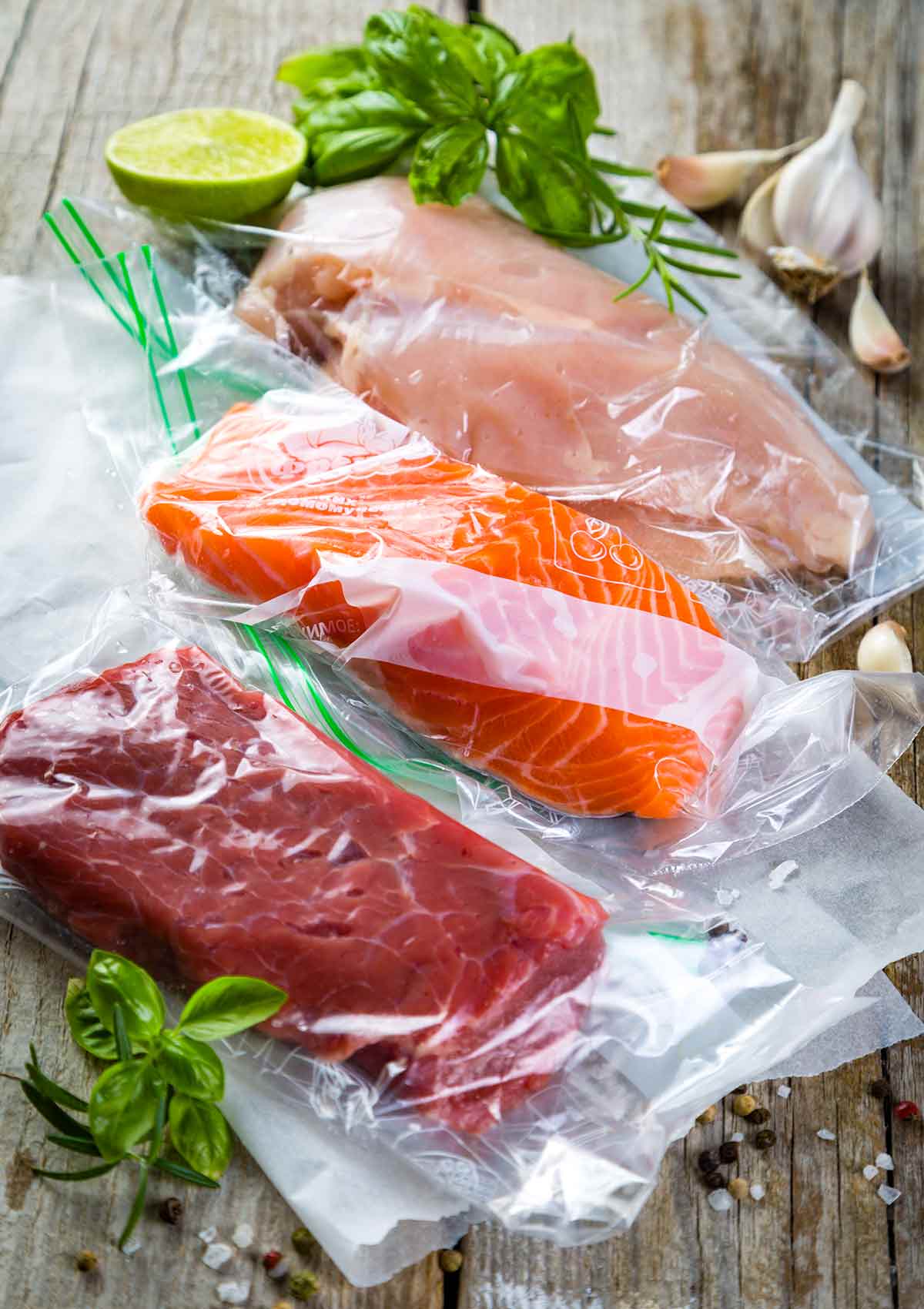
We often get asked, “What is sous vide, anyway?” Like always, we’re here for you. Say hello to our rundown of the phenomenon that is sous vide cooking—what it is, what you need, how it works, and some really valuable tips and tricks.
Contents
- How does sous vide work?
- How long does sous vide take?
- What temperature do I cook at with sous vide?
- Is it possible to overcook something sous vide?
- What’s the best sous vide machine?
- How to gauge cooking time in your sous vide machine
- Are there any food safety issues with sous vide?
- What if I don’t have a vacuum sealer?
- How can I ensure my bags don’t leak?
- How to set up your water bath
- Is there anything I can’t make with my sous vide machine?
- How can I make sous vide food look pretty?
- How to convert a regular recipe to sous vide
- Is cooking sous vide healthy?
- How to stash your freezer with sous vide cooking
- How to clean your sous vide machine
- How sous vide is a godsend when entertaining
- Are there any downsides to sous vide cooking?
We’ve all watched celebrity chefs on TV quickly take some ingredient—fish, meat, vegetable, even fruit—and proceed to season it, place it in a plastic bag, vacuum-seal it, drop it in a water bath, and then seemingly forget about it.
This cooking technique is known as “sous vide,” a term borrowed from the French that translates to “under vacuum.” Simply put, sous vide is similar to poaching except the food is first vacuum-sealed. It’s then cooked in water held at a very precise, steady, and low temperature for a considerably longer amount of time than traditional methods of cooking.
The sous vide method of cooking has helped professional chefs send out consistently and perfectly cooked meals without fail for years. Yet it’s no longer an elite technique limited to master chefs. It’s a modern method that’s increasingly popular with home cooks. I purchased my initial unit, the SousVide Supreme, in 2010. That was the first company to sell a product specifically for the home cook at a reasonable price. Back then, I very quickly found that there was little information on this new adventure in cooking. As a result, there was quite a lot of trial and error as I learned what worked and what didn’t. Because I didn’t understand how thickness affected cooking time or how easy it is to overcook food, my early lessons came from ruining more than one steak.
As time and technology progressed, more reasonably priced water circulators, or sous vide machines, became available to home cooks. Other companies, including Anova and Joule, entered the market, and information on how to properly sous vide became increasingly abundant. Today there are dozens of cookbooks, websites, and hashtags dedicated to sous vide cookery, and renowned chefs, including Thomas Keller and Hugh Acheson, broadcast their insights and recipes.
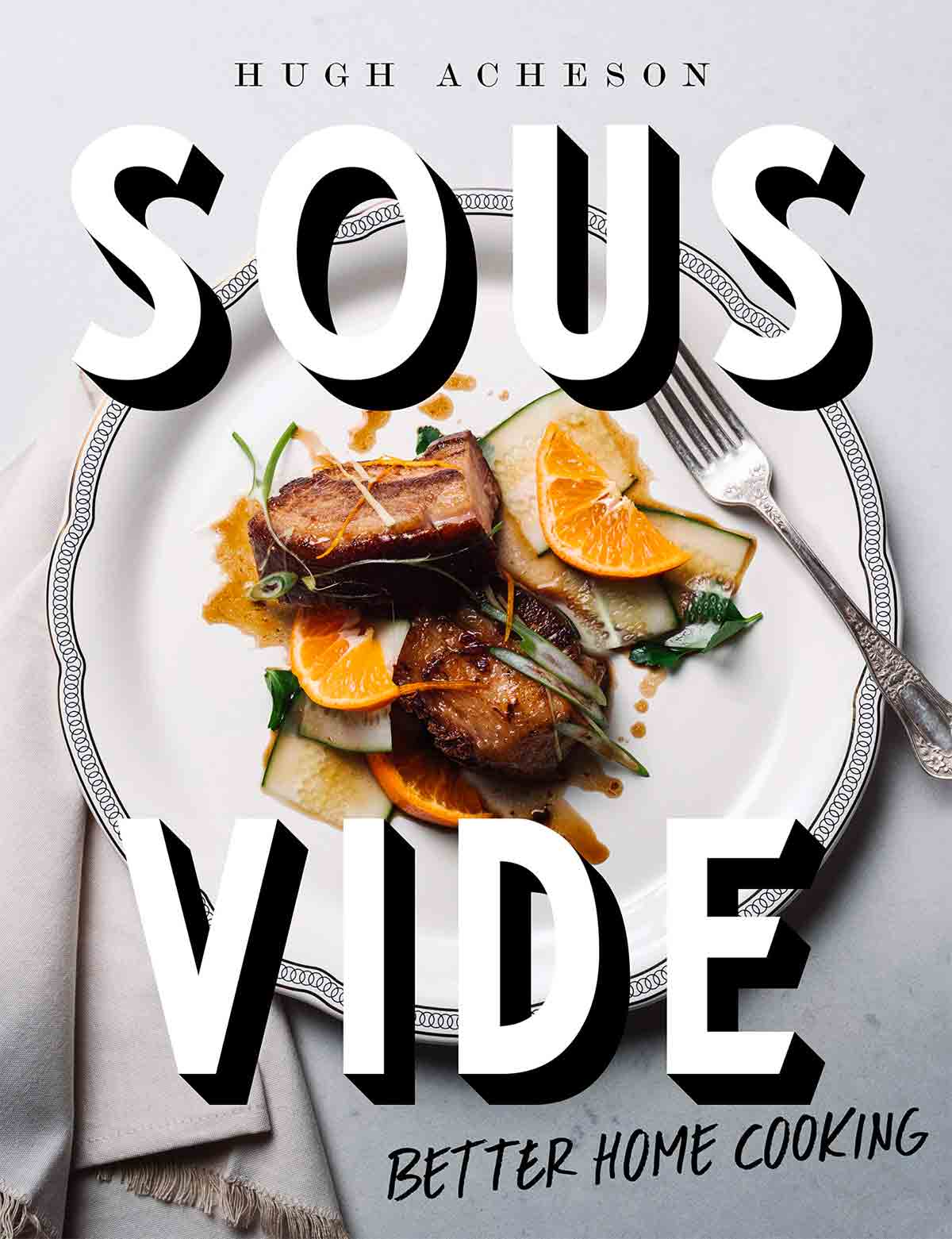
Yes, sous vide cooking is different, although it’s not difficult. As with most things in life, there’s simply a learning curve. We surveyed our recipe testers to find out about their familiarity with sous vide cookery and their thoughts on its use in their home kitchens. (In case you didn’t know, Leite’s Culinaria has hundreds of recipe testers who make and review the recipes that eventually make it onto our site.) Their expertise ranges include younger as well as “beginner” home cooks, more advanced home cooks who have had some cooking training, and professional chefs and recipe developers. What we discovered is that about half of them have owned and used some sort of sous vide device. Here are the insights, tips, tricks, and takeaways that can help make your experience with sous vide an easy one.
How does sous vide work?
The most popular sous vide tool among home cooks is known as an immersion circulator, which is quite similar in size and shape to an immersion blender. This is attached to a water bath of some sort, usually contained in a large pot, deep pan or pot, or plastic tub. The immersion circulator consists of a temperature control unit, heating element, and small pump that pulls and expels water so that warmth steadily circulates around. These components provide a steady and precise temperature of water for cooking food.
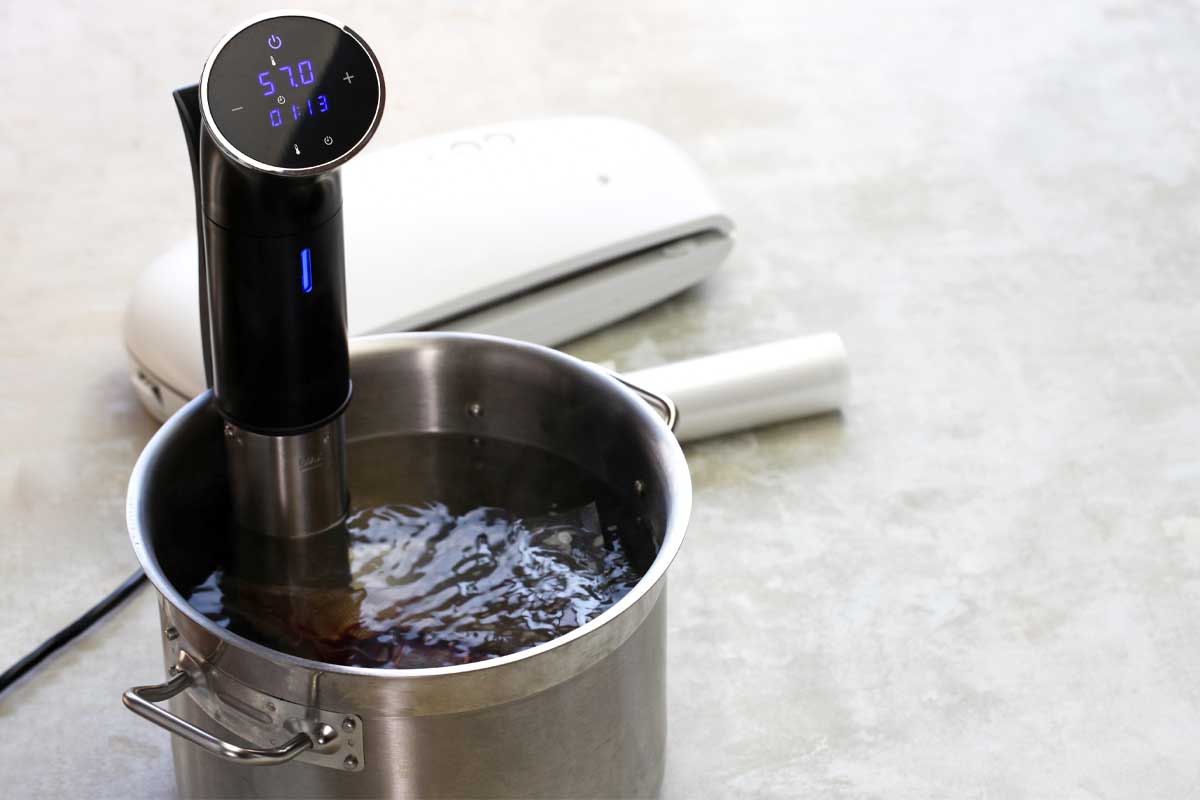
Sous vide allows you to maintain a constant temperature while cooking, as compared to an oven or stovetop where temperatures will fluctuate. An oven can fluctuate as much as plus or minus 50°F (10°C), which will impact your cooking time and the quality of whatever you’re cooking.
How long does sous vide take?
Sous vide is a slow method of cooking. It will take time for your water bath to come up to temperature, plus whatever cooking time you require to get your ingredient to the proper and safe internal temperature. Some foods, such as shrimp or a fish fillet, cook perfectly in about 30 minutes, while poultry or meat may take a few hours to a full day.
This time is a gift. Sous vide provides the home cook with an immense amount of flexibility. Since your cooking window can be up to several hours, you have the opportunity to multitask without having to worry about hovering over the stovetop or standing by the oven and keeping careful watch. And your food can stay on temperature for up to 90 minutes after reaching its cooked temperature without any harm. So if your Zoom meeting runs long, the kids want you to play or watch a movie, or you get distracted by [fill in the blank], dinner can still be salvaged.

What temperature do I cook at with sous vide?
It depends on what you’re cooking. Food typically begins cooking as low as 130°F (55°C) for meat and seafood and up to 185°F (85°C) for vegetables and fruits. It’s important to research and re-read recipes. Research cooking times well, as excessively long cook times may be too long for your product, such as fish versus a steak.
Is it possible to overcook something sous vide?
Yes, you can. But it’s not easy.
Cooking a steak in a cast-iron skillet requires a lot of watching and you have a very narrow window of time for desired doneness and, sometimes in a matter of seconds, you can quickly overcook it. Cooking sous vide will maintain your steak at the exact temperature you want—whether medium or medium-rare—for a window of about an hour. Therefore, things will rarely overcook as compared to traditional cooking.
What’s the best sous vide machine?
My original Sous Vide Supreme is still heating up a storm, and I’ve added two Anova circulators to my kitchen tool kit. The Anova device was the most popular immersion circulator with our testers with an almost 4 to 1 ratio over the Joule. Either unit can be used with a wide range of water bath tank sizes. The Joule requires the purchase of an adapter to use on non-metal surfaces since it has a magnetized base that holds it in place in a large pot. The Anova and others are made to hang on the side of any container. Most home cooks use either a pot or a plastic tub for the water bath.
High-end units that are professional grade, such as the Poly Science models, can easily cost more than $1000. Home cooks can find some good quality versions for under $200 and closer to $100 when on sale.
How to gauge cooking time in your sous vide machine
There will be a learning curve to understanding the difference between how tender meats and tough meats respond to temperature, and learning of the transition of connective tissue to gelatin. It’s most important to understand the “race” between bacterial growth and bacterial destruction as a function of temperature. Cooking your product in the water bath will kill bacteria at temperatures above 130°F (55°C), so in essence, cooking sous vide is like pasteurizing your meal as you have it under a temperature for a sustained period of time.
It’s also important to know that once you finish cooking, if you don’t plan on using your food right away. It needs to be chilled quickly in ice water and promptly placed in the fridge or freezer.
Are there any food safety issues with sous vide?
Food safety is of critical importance. In addition to the threshold temperature required to kill bacteria mentioned above, if you’re not using the food right away, make sure you cool it in ice water and then immediately put it in the fridge or freezer. It’s incredibly easy to create make-ahead meals with your sous vide and warm them up later, straight out of the fridge or freezer.
What if I don’t have a vacuum sealer?
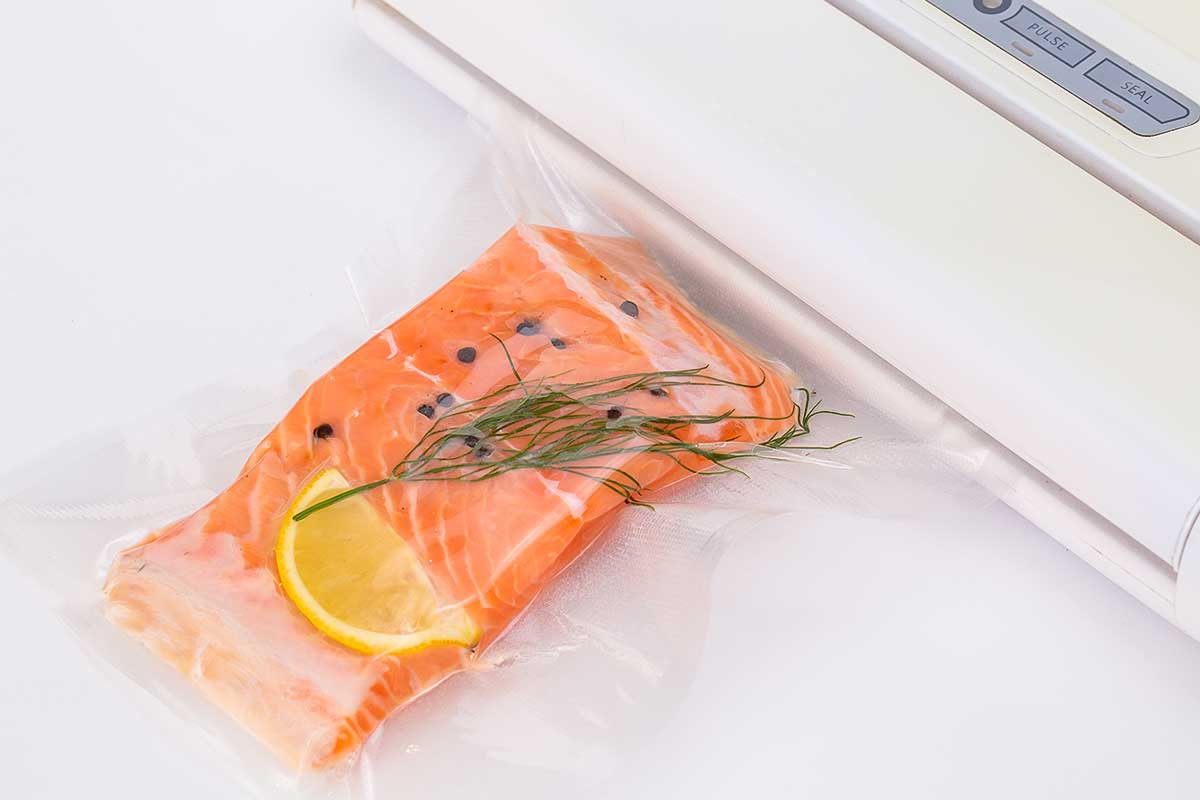
Most of our testers use precut vacuum sealer bags or make their own using a “Food Saver” vacuum sealer or similar device. You can instead use resealable plastic bags. A method used by a third of our testers when cooking sous vide at home. You can also use reusable silicone bags, which have landed on the market and are popular among those who prefer to reduce plastic waste.
If using resealable plastic bags, you will need to know how to get the air out of them properly. If we head back to 8th-grade science class, you might recall the Archimedes Principle, which relates to the physical law of buoyancy and water displacement. To get the air out of a bag: fill a pot with cold water, seal the bag except for about a “one finger” space, then slowly immerse the bag in the cold water. As you submerge the bag, the water will push the air up and out. Finish sealing the bag after pushing out the air.
One thing to consider as an ongoing expense with sous vide cooking pertains to the bags. An advantage of using a vacuum sealer, over using a resealable plastic bag, is that the flavors of a marinade will penetrate more quickly and intensely with a vacuum sealer. I’ve discovered that when a small amount of marinade for chicken, steak, or fish is added to the bag and vacuum sealed, it really adds quite a bit of flavor and it’s a great way to quickly marinate something.

How can I ensure my bags don’t leak?
Take care when sealing your bags. You do not want your bag to leak into the water bath. If you’re using a vacuum sealer to create bags, seal the bottom of your bag twice. After you have the ingredients in the pouch and under vacuum, seal the top twice. These extra seals will save you angst later.
If you’re working with chops, ribs, or bone-in anything, it’s always good to place some foil around the tips of the bones to prevent any protuberances from piercing the bag.
How to set up your water bath
Dealing with the large amount of water needed for a sous vide machine is a royal pain if the only counter space for the machine is across the room from the sink. So many cooks set up the water bath close to their water source. This also makes it easier to dispose of the water later.
I generally use a large pot that I cover with ping pong balls to retain the heat. Aluminum foil also works like a charm to help trap the heat.
For high-volume cooking, I bought an inexpensive 22-quart Cambro box from a restaurant supply store. I then cut a hole in the lid for the Anova unit. Many people have converted plastic insulated coolers to use with their sous vide device. Some sous vide devices have built-in water baths. And Instant Pot is now offering a sous vide feature on their all-in-one cooking units.
When you place your bag in the water bath, your product needs to be fully submerged. You can do this several ways. One, is to use metal binder clips, or other spring clips, to hold the sealed bag top to the side of the pot so that it hangs at the right height in the water bath. I found some inexpensive nylon spring clips online to avoid the heat transfer up to your hands when you must take them off later. Alternatively, you may use some weights to place over the bag to keep it underwater. (I’ve used bacon presses in a pinch!) Those ping pong balls I use to fill the top of the water bath also help to keep the bags underwater, as well as provide insulation to keep the water at temperature.
Is there anything I can’t make with my sous vide machine?
It’s not easy to find a bag big enough for something like a crown pork roast, so there are limitations on what you can cook depending on the size of your sealed bag and the size of your water bath.
How can I make sous vide food look pretty?
Your product may look awful coming out of the water bath. Meat, especially beef, is extremely ugly and unappetizing when you first pull it out of the bag. However, it simply needs to be re-seasoned and seared at high heat for a minute or so on each side to give it the browned look and taste you’re looking for. You can also sear steaks or chops before cooking them sous vide. Either way, be sure to save the jus from searing to make a pan sauce.
How to convert a regular recipe to sous vide
You can usually convert a standard recipe to the sous vide method with a few tweaks. The sous vide cooking time should be the only real change. The key here is to research your specific product’s sous vide cooking time for a particular ingredient and then adjust.
For example, I have a wonderful recipe for shrimp and grits that I’ve partially converted to sous vide. I make my andouille sausage and onion sauce on the stovetop, then chill it. I then add that sauce to a bag with my shrimp, seal it, and toss it in the fridge to sous vide later. I’ve made my cheesy grits earlier as well and have those in a bag ready to reheat in the sous vide. Makes dinner parties really easy!

Some things that can be done sous vide don’t actually make a lot of sense to do. Except as a science experiment or if cooking for a large group. For instance, making soft-boiled eggs sous vide produces great eggs but takes about an hour. Once you’ve done it just for the experience of it, you may not want to do it again.
Is cooking sous vide healthy?
A major benefit of sous vide is that cooking food at a low temperature in an enclosed environment over a period of time ensures that it retains not only moisture but nutrients.
Conventional cooking exposes food directly to heat, water, and oxygen. That can cause some of the nutrients in the food to become destabilized or otherwise unavailable. Studies indicate that boiling vegetables in a pot can eradicate as much as 50% of their vitamins and minerals. This same sort of depletion also occurs when meat is charring on the grill.
Also, the vacuum sealing process helps marinades and other seasoning ingredients to infuse the food. This means if you have any particular limitations when it comes to fat, sugar, or sodium content, you’ll find that very little of these need to be added to achieve the flavor you want. Keep this in mind so you don’t over season your product. Sous vide requires less salt and pepper, so adjust your seasoning, if needed, when you are finishing your dish.
How to stash your freezer with sous vide cooking
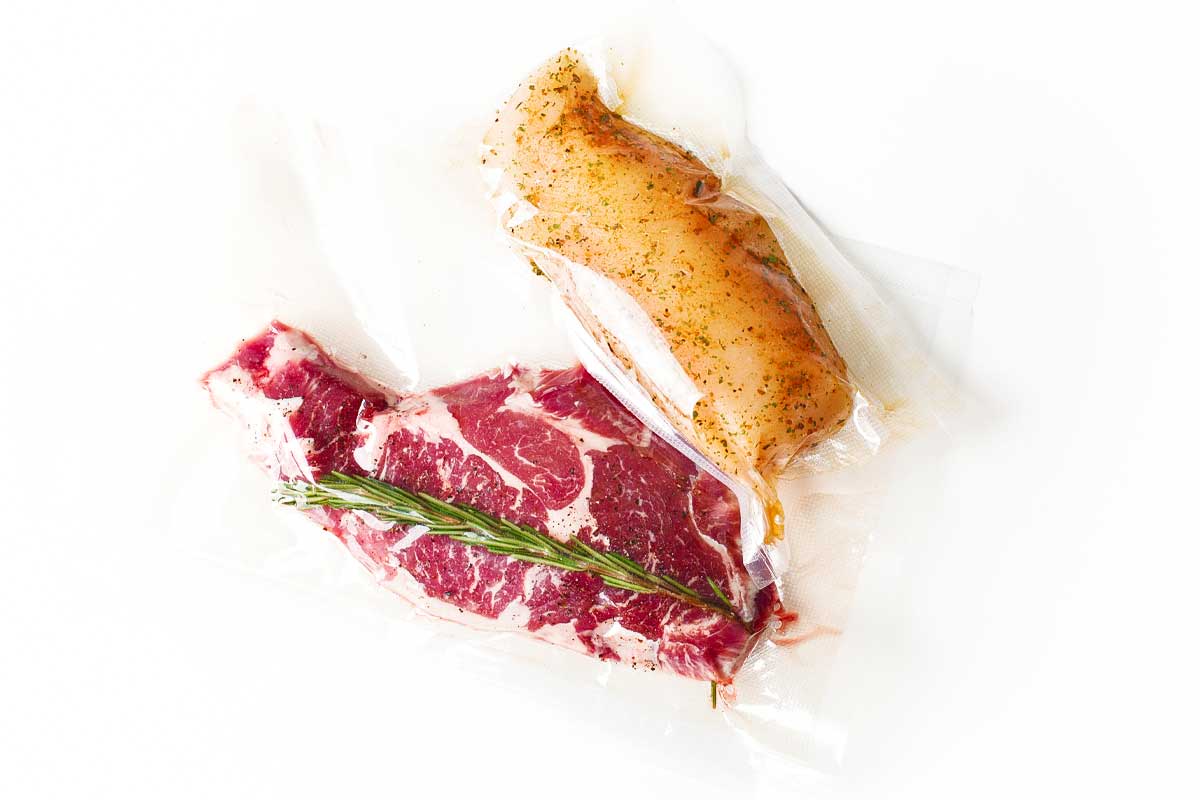
It’s a cinch to add seasonings or a marinade to food, vacuum seal it in individual portions, and then freeze it before cooking. When you’re ready to cook, thaw as many or as few portions as you need in the fridge overnight, and it’s ready to sous vide the next day. You can also place a frozen bag right in the preheated water bath and cook it. The standard rule of thumb is to add 50% more time when cooking something from a frozen state.
Quite often I stock up on large quantities of seafood or meats when shopping at big-box stores. When I get home, I parse them out into meals for 2 or 4 individuals that–all ready to be cooked sous vide.
Don’t forget that you can also vacuum seal leftovers and use your sous vide to reheat them later without worrying about overcooking them. Keep in mind that the key here is to reheat your meal at a temperature a few degrees less than what you cooked it at so it won’t overcook.
How to clean your sous vide machine
You will need to clean the circulator now and again to get rid of mineral deposits unless you’re using filtered water instead of tap water. I soak mine in CLR, but any commercial “descaler” will work well to remove lime and calcium deposits. It’s not a big deal unless you use the unit quite frequently.
How sous vide is a godsend when entertaining
My sous vide machine isn’t something I use every day. I tend to go through periods where it sees a lot of use, then a bit of abandonment. But whenever I’m throwing a dinner party, I use it to help make those dinners perfect. And it helps me prepare things in advance and not spend as much time away from my guests.

Are there any downsides to sous vide cooking?
I will admit, there is a downside to sous vide cooking. As one who enjoys cooking, I think my sense of taste and smell is often the key to a great meal. One of the greatest pleasures I get from cooking is the sound of onions starting to sizzle in butter as they hit the skillet or the fragrant aromas that permeate my kitchen while a sauce simmers. Most of us tend to judge how well something is progressing through taste, smell, and touch as we prepare it.
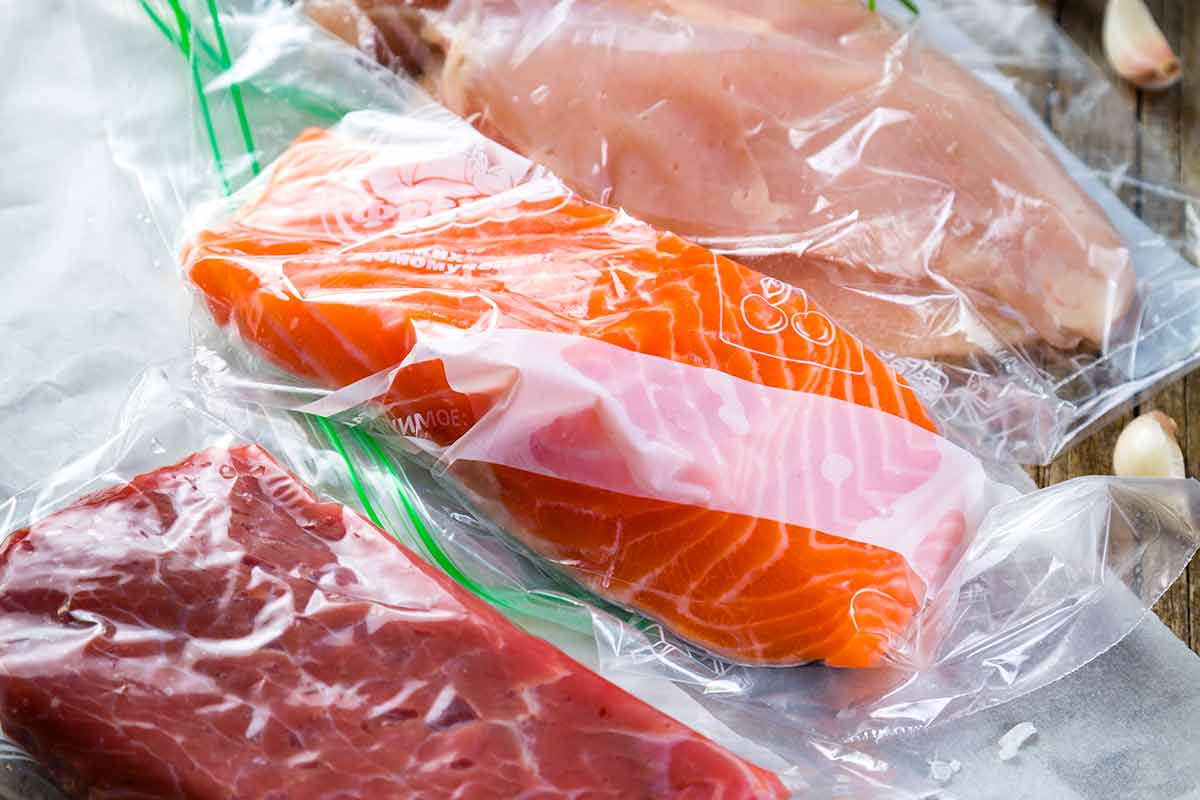
While we can’t experience this through “pure” sous vide cooking, using sous vide in addition to other cooking methods will always produce great results. That’s the key to how I use sous vide in my kitchen. I make sauces ahead of time, let them cool in an ice bath, freeze some for later, and add some to whatever particular food I may be cooking sous vide.
For example, sous vide shrimp always come out perfect. I’ll make up a batch of peel-and-eat shrimp in 20 to 30 minutes in the sous vide and then chill it in an ice bath for a killer shrimp cocktail. Other times I’ll make shrimp and grits, starting with making a big batch of tomato-based sauce fortified with andouille, onion, and garlic. I’ll freeze some of the sauce for later as well as add some to a bag of shrimp which I then let marinate in the fridge for a while before cooking them sous vide. I pour the finished product right over some grits, knowing my sauce is perfect.
It can be a matter of achieving harmony using sous vide with other cooking methods rather than an either/or situation.
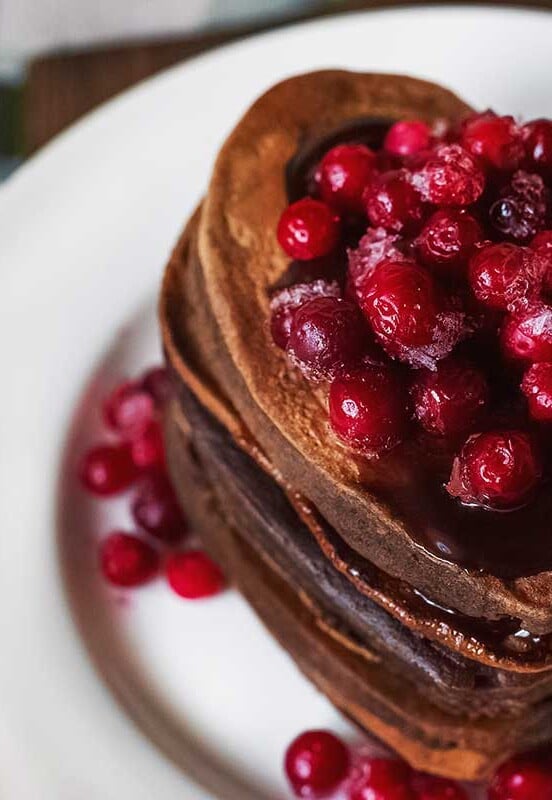
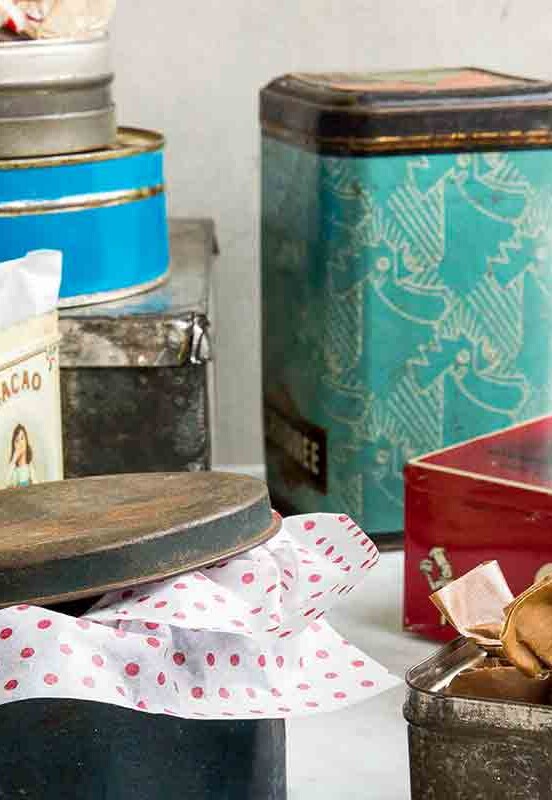










The ONLY way to cook a beautiful filet mignon is through sous vide. Why take a chance on ruining an expensive piece of meat by overcooking it! I always have some red wine reduction in the freezer for a last minute sauce. Great article Craig!
Hi Linda, I’m so glad you enjoyed the article. I agree that it works great on a filet. I made a couple of “Juicy Lucy” burgers last week, and its such a versatile tool for the kitchen!
AMEN! Couldn’t agree more.
Nothing in 60-some years of cooking has improved my “roasted” meats like my Joule. And one of the things I’ve learned is that if a large piece like a roast or a brisket or something isn’t memorable I can seal it back up, “cook” it some more and it will get there for a second serving.
I’m a big fan of presearing while the flesh is malieable and will make maximum contact with the hot pan. If a second “searing” in a really hot oven will improve the appearance I can do that in the 10 minutes it takes to turn the drained liquids into a gravy.
All sous vide cooking takes is the planning to start early enough. Sometimes even 24 hours before serving time.
Hi Rainey,
Thank you for your comment. I found it amazing myself when I first started cooking sous vide, both to the consistency of the final product, and the ability to finalize the rest of the meal, and yet not worrying about overcooking the protein. I think sous vide cookery is quite the lifesaver for large dinner parties (or small ones), and with proper planning, everything comes together almost all at once!
Craig
I made my first foray into it a long time ago before circulation machines became available. Can’t remember how a cooking bud and I jerry-rigged a sous vide set up but we came up with something. We cooked a couple salmon filets. And we were so green we didn’t know we should have let the “finished” filets hit the hot pan.
You can imagine how disappointed with soggy salmon and sous vide cooking we were! It took another decade for the circulators to come along and then a good bit of convincing by my buddy but the lesson was learned and we’ve never looked back!
If I were a working person it would be my lifeline. No more depending on overdone slow cooker meals.
Hi Rainey, It amazed me as to how this long this method of cooking has been around, and that it took so long for it to become a more popular method for the home cook.